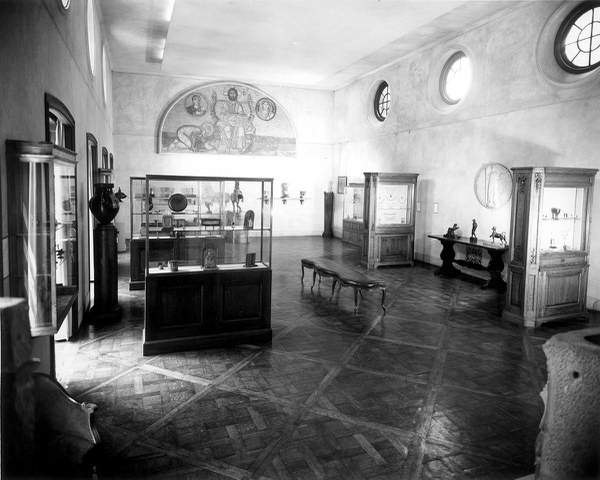Dumbarton Oaks Byzantine Collection, 1940 Installation.
In preparation for the inauguration of the Dumbarton Oaks Research Library and Collection in November 1940, Mildred and Robert Woods Bliss laid considerable groundwork beginning in 1937. They aggressively increased their collection of Byzantine and related artworks, creating what Walter Muir Whitehill would later call “not only a representative group of Byzantine objects in many materials, but pieces that illustrated the derivation of the style from classical antiquity and exemplified the extraneous elements brought into the Empire by barbarian invaders.”

The Blisses worked with the architect Thomas T. Waterman to design and build library and exhibition pavilions to the west of their Music Room, and in these additions they incorporated mosaics from the Antioch excavations that they had helped to fund. They engaged Marvin Ross to catalog the expanded Byzantine Collection, Elizabeth Bland to register and help install the collection, Barbara Sessions to assemble and catalog the research library (which by 1940 numbered some twelve thousand books), and Ethel B. Clark to catalog Mildred Bliss’s rare books, manuscripts, and holographic materials. They initiated the Census of Byzantine and Early Christian Objects in North American Collections, employing researchers Louisa Bellinger and Elizabeth Dow to undertake this task. They acquired for Dumbarton Oaks a copy of the Princeton Index of Christian Art, and initiated the Dumbarton Oaks Papers in the hope that scholars would publish articles on objects in the collection. All of this was in place when the Dumbarton Oaks Research Library and Collection transferred to Harvard in 1940.
However, in making this gift, Mildred and Robert Woods Bliss provided little direction for the development of the nascent research institute. Their letter to Harvard’s president announcing the gift stated rather simply their desire that Dumbarton Oaks “be used for study and research in the Humanities and Fine Arts, with especial emphasis upon Byzantine art and the history and culture of the Eastern Empire in all its aspects.” They further expressed their hope that Dumbarton Oaks itself would become a center of research and a place of residence for scholars, students, and artists. In a 1939 letter to her friend, Royall Tyler, Mildred Bliss was better able to articulate the general atmosphere she desired for the institution. She wrote, “I know that what Dumbarton Oaks has to give—the work that it can do—can never be done in a big center—it must be small and quiet and unemphatic: a place for meditation and recueillement.” She famously reiterated this sentiment, albeit after the fact, in the 1966 preamble to her last will and testament, where she wrote that “Dumbarton Oaks is conceived in a new pattern, where quality and not number shall determine the choice of its scholars; it is the home of the Humanities, not a mere aggregation of books and objects of art.”

The direction that Dumbarton Oaks would take during its first decade would be left, however, to the new Administrative Committee (called the Administrative Board until 1942), which was chaired by Paul Sachs, Harvard professor and associate director of the Fogg Art Museum at Harvard University. This committee appointed staff and fellows, assisted in acquisitions for the library and collection, and most importantly, devised a scholarly program for the new research institute. The growth and development of Dumbarton Oaks, as well as its initial successes and failures, would be determined by the decisions that the Administrative Committee made in its early years.

